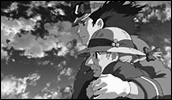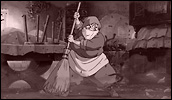Howl’s Moving Castle
- Year
- 2004
- Original title
- Hauru no Ugoku Shiro
- Japanese title
- ハウルの動く城
- Director
- Cast
- Running time
- 119 minutes
- Published
- 29 November 2004



by Jasper Sharp
A new movie from the most cherished animation studio in Japan is always a highly anticipated event. For more than a decade, the latest works of Ghibli's two main driving forces, Hayao Miyazaki and the oft-overlooked Isao Takahata, alongside their team of imaginative and highly-skilled animators, have taken the domestic box office by storm.
Princess Mononoke was a commercial success second only to Titanic in the year of its release, while Spirited Away went one step further to become the highest-grossing movie in Japanese history. More significantly, it represented Miyazaki's long-overdue acknowledgement on the world stage when in 2003 it won both the Golden Bear at Berlin and the Oscar for Best Animated Feature.
This new overseas critical recognition, as well as the much-discussed international distribution deal through Disney's Miramax arm, seems to be somewhat of a mixed blessing. No longer is Miyazaki making films solely for Japanese audiences. He now has the whole world to answer to. Spirited Away and Princess Mononoke were the first experience of a Ghibli film for the majority of foreign viewers, and thus, with their roving, expansive plots and their eclectic use of ancient and traditional Japanese iconography, were seen by many as being typical of Miyazaki's body of work.
Studio Ghibli is now seen as marching at the forefront of what is being misleadingly touted as the "new" globalisation of Japanese animation. As social commentators gazing eastwards write reams attempting to explain the culturally-specific messages inherent in Pokemon and Sailor Moon whilst Tarantino and the Wachowski brothers fuel their works with elements from titles familiar only to the most ardent fanboy, Japanese animation is still being posited as something alien and antithetical to the Disneyfied norm. The fact that animated works stemming from Japan have been playing internationally for almost half a century is something that has been conveniently overlooked. What it boils down to is that foreigners are now primed to expect something different from Japanese animation than they would get from that of the West.
This tired East-West dichotomy of course ignores the fact that not only is there a myriad of styles and approaches within Western animation (the works of, to name but two, Frenchman Michel Ocelot and the Russian Yuri Norstein, both championed by the Ghibli animators, are all easily available for viewing in Japan), but also that Japanese animation is not just one single, monolithic entity.
This is readily apparent even when one looks at the major animated features that were put out into Japanese cinemas in 2004 - the dazzlingly slick Appleseed, the perplexing Ghost in the Shell II: Innocence, the ambitious but ultimately disappointing Steamboy, and, my personal pick of the punch, Studio 4C's virtually indescribable Mind Game. The question is, will Miyazaki's work stand out amongst this slew of animated competition in the way it has done in previous years?
I mention all of this beforehand, because already I have heard mumblings, and from Japanese critics as well, that Howl's Moving Castle is "not typical Miyazaki", and lacks the personal touches that made his earlier work so memorable. At least part of the reasoning behind this judgement seems to be that not only did the source material for the project originate outside of Miyazaki - Kiki's Delivery Service in 1989, an adaptation of a book by Eiko Kadono, was the last time he directed a story written by someone else - but it also came from outside of Japan, from the novel of the same name by British children's writer Diana Wynne Jones that was published in 1986.
Another part of this may also be down to the unconventional lead character of Sophie, who is transformed within the opening scenes from an 18-year-old girl who works in her family-owned hat shop into a wizened crone with an oversized hooter and creaking bones by a curse from the Wicked Witch of the Waste (played by that wonderful icon of camp, Akihiro Miwa, the cross-dressing cabaret singer from Fukasaku's Black Lizard who previously lent his vocal talents to the character of Moro in Princess Mononoke). In this form she remains for the rest of the film, as her shocking transformation forces her to leave home, unable to face her family, which in turn brings her into contact with the Wizard Howl and his moving castle.
Upon entering the castle, which looks like a giant pig on chicken's feet, phallic guns jutting from its portholes, smoke billowing from its stacks, and steam hissing from its joints as it stumbles across its picturesque backdrop of alpine meadows, Sophie makes the acquaintance of Calcifer, a crotchety fire demon inhabiting the bowels of the castle. Calcifer has been put to the task of keeping the home fires burning and the castle moving by way of a magic spell from its owner, Howl, and as Sophie adopts the role of castle housekeeper, the two make a deal that if she can persuade Howl to break the spell and release him from this service, then he will in turn reverse the aging curse imposed by the Wicked Witch of the Waste.
This decision to break with Miyazaki's own storytelling tradition of using adolescent girls as protagonists may be an attempt to forestall some of the prurient conjecturing his works have received in some quarters, but these cute young audience identification figures, nevertheless, remain a crucial element of the appeal of his work. Even in animation where anything goes, it's a brave move making a 90-year-old granny the centrepiece of the tale, even if she does have the heart of an 18 year-old. This tension between internal disposition and external appearances, however, turns out to be a crucial aspect of the plot, where even the most handsome young wizard may have a monstrous feathery creature slathering inside him, and it takes more than plain old-fashioned magic to keep the Wicked Witch of the Waste's seeping aged flesh from sagging around her knees.
Of course, while we are on the subject of surface appearances, the one thing you are guaranteed with a Studio Ghibli film is the high quality of the animation, not to mention the dense visual worlds rich with incidental detail that the stories unfold in. On this level at least, aside from the fact that it contains numerous elements included in his other works - teenage magicians and their familiars, evil witches, epic battles between good and evil and some of the most astounding vertiginous aerial sequences ever staged in a Ghibli film - Howl's Moving Castle is instantly recognisable as stemming from the fecund imagination of its creator.
Set within an imaginary 19th-century European setting where magic and science combine (in an interesting parallel with Steamboy), as with Nausicaa: Valley of the Wind and Princess Mononoke, this quaint idyll has fallen prey to war, with sturdy tanks patrolling the streets and strange dirigibles and torpedo-shaped flying machines scattering bombs and propaganda leaflets on its citizens from high above. In the opening scenes as Sophie walks along the cobbled streets, ghostlike black shapes oozing from the walls of the timber-framed houses behind her, she is harassed by two Prussian-suited military men, only to be saved by a beautiful tussle-headed young man, who magically whisks her through the air back onto her veranda.
In this instance, rather than a possible solution lying in the hands of a teenage girl, the story is more focused on the individual characters, including Sophie, Calcifer, Howl, a young wizard known as Markl, his whiffling doglike accomplice Heen and a pogoing animated scarecrow referred to simply as Turnip (or Kabu), as the main warmongers remain aloof figures in the background. The constant shadow of war permeates the story, as it is through the mediations and interactions of these central characters, rather than that of the high up powers that engage in a power struggle way outside of the interests of the general citizens, that any possible solution looks set to be found.
You can divide Miyazaki's works into two camps. The smaller, more personal works such as My Neighbour Totoro or Porco Rosso, and the more grandiose epics such as his last two features. This latest somewhat straddles the two approaches, reigning in the requirements of the story within a two-hour running time (something of a relief for those such as myself who made the unpopular criticism that Miyazaki's most recent works were simply just too long and baggy) yet whisking us onwards from scene to scene with a relentless momentum.
Despite its use of foreign source material, tailored by Miyazaki to suit his own needs, Howl's Moving Castle is neither markedly better nor worse than any of his brilliant previous works. Neither particularly similar nor radically different, it is a film that can, and no doubt will, be savoured again and again, revealing different aspects to different people upon different viewings. How it fares at the box office or whether it is the last film Miyazaki directs is irrelevant, because it is ultimately as timeless and magical as anything else ever released by the studio.